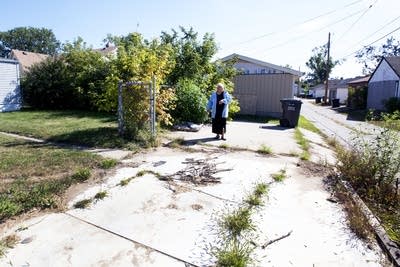Mpls. grapples with backlog of tornado-damaged homes

The north Minneapolis street where 76-year-old Doris Jones has lived since the early 1960s used to be shaded by a leafy canopy of tall trees. The tornado that ripped through the neighborhood on May 22 took down all but one of those trees. Some of the trees fell onto people's homes. Now, her living room window faces an empty lot where her neighbor's home used to be.
"Every street on the north side was blocked off with trees. You couldn't get through here, no kind of way," Jones said.
Four months later, contractors are still working on her house, which sustained about $76,000 in damage. It needed a new roof and chimney, new siding, gutters and windows, a new garage and fence. Jones is thankful her homeowners insurance is covering the damage.
"Once they cleared away the debris and the trees from in front of the house and things out of the street, I was able to live in my house when other people around here weren't," Jones said.
Create a More Connected Minnesota
MPR News is your trusted resource for the news you need. With your support, MPR News brings accessible, courageous journalism and authentic conversation to everyone - free of paywalls and barriers. Your gift makes a difference.
The tornado struck the neighborhood four months ago, leaving behind millions of dollars in destruction. Every street in the tornado zone seems crowded with construction vehicles. The air is filled with the sound of hammering, but work has yet to begin on many damaged buildings.
City inspectors are trying to determine how many homes in the tornado damage zone remain unrepaired, so they can assess how to best help those people who still need assistance before winter sets in.
"There are a number of properties that we still see in the tornado impact area that have blue tarps on their roofs," said director of housing inspections Tom Deegan, who said the city wants to know why.
"Is it that they don't have the resources, were they uninsured, underinsured," he said. "Did the insurance only cover 'X' amount of damage and not enough to get it all done."
The city lists 206 properties as having major damage from the tornado. About 1,200 have minor damage. Deegan said city inspectors are fanning out across the tornado zone for another look.
"They are going to look at roofs — if they were impacted by the tornado, how many shingles, what percentage of damage, do they still have a tarp on them. They are going to look at the windows, they are going to look at the doors and look at the siding," Deegan said.
The inspectors will cross-reference the tornado damage they find now with the city's master list of damaged properties. Then they'll investigate the idle properties that have active construction permits and ask the owners about the status of the repair work. So far, 2,063 construction permits have been pulled for tornado damaged properties, but Deegan said many homes have multiple permits, making it difficult to firmly account for the number properties actually being fixed.
"The goal is to do an overall assessment of the general conditions of these properties in the area," he said.
For many people in the tornado zone, repairs are a question of money.
The city doesn't know exactly how many property owners are uninsured or underinsured. After the storm, officials estimated that approximately 40 percent of homes and rental properties in the zone were uninsured, and that even most of the owners with insurance would not have enough coverage to pay for repairs. Most of the people in this category also didn't qualify for other disaster assistance.
To help close this gap, a city program offers a forgivable loan. The state provided $1 million dollars for the program, called Quick Start. At least 50 people in this situation have already applied for up to $30,000 in tornado damage loans.
Cherie Shoquist, the city's foreclosure recovery coordinator, said they hope to help as many as 100 people fix and restore their homes to pre-tornado condition.
Even with that financing help, the city, county, state and nonprofit groups continue to raise money in order to help as many people as possible finish tornado repairs by December so homes don't suffer even more damage in the cold.


